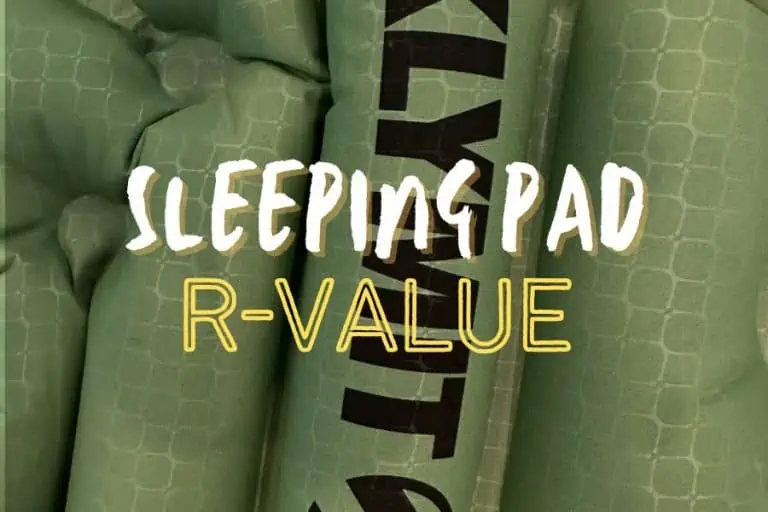Buying a sleeping pad? You may already know the size, insulation type and even the brand you want to go for.
But do you know the R-value? The R-value is an important factor that will affect how comfortable you’ll be while sleeping.
And if you don’t know anything about this rating, don’t worry. That’s why we’re here today.
In this article, we’ll go over everything you need to know about R-value, as well as how to implement it when searching for the best sleeping pad. Let’s dive in!
What is Sleeping Pad R-value?
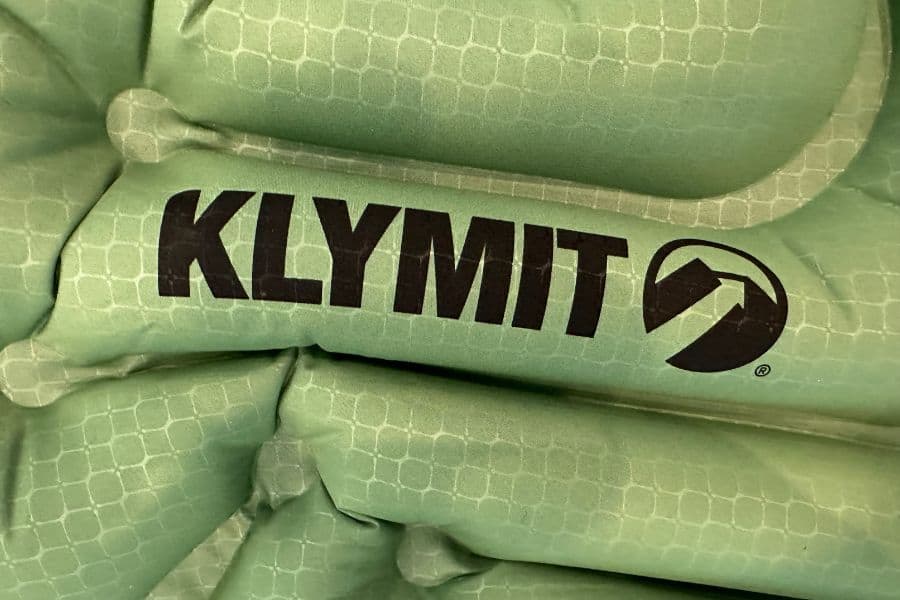
Every camper knows how cold the ground can get at night. And if you were to sleep on it directly, you’d be freezing.
No matter how thick your sleeping bag might be (even a zero degree bag), it will get compressed at the bottom underneath your weight.
Can you avoid that? You absolutely can.
That’s why sleeping pads are for. This piece of camping gear creates a layer of protection between your body and the ground.
Nowadays, you can find tons of sleeping pads on the market, all with different characteristics.
Which may get you wondering – how does one find the most suitable model for them?
Well, that’s why you have R-value.
R-value measures how well a sleeping pad can resist heat transfer.
The R-value scale starts with the number 1 and the higher the number, the better it can keep your body insulated from the cold ground.
So for instance, a sleeping pad with an R-value of 2 is half as insulated as one with a rating of 4.
Sleeping Pad R-Value Chart by Temperature
Alright, let’s get technical. The R-value scale is pretty straightforward, but what does each number actually mean?
R-VALUE | SEASON | DEGREES (FAHRENHEIT) | DEGREES (CELCIUS) |
1 | SUMMER | 50° | 10° |
2 | SPRING, SUMMER, FALL | 30° | -1° |
3 | SPRING, SUMMER, FALL | 25° | -4° |
4 | SPRING, SUMMER, FALL | 10° | -12° |
5 | WINTER | 0° | -18° |
6 | WINTER | -15° | -26° |
7 | WINTER, EXTREME | -25° | -32° |
8 | EXTREME | -40° | -40° |
Clearly, your choice of sleeping pad depends on the temperature you’ll be experiencing when camping
Sleeping Pad R-Value Chart by Season
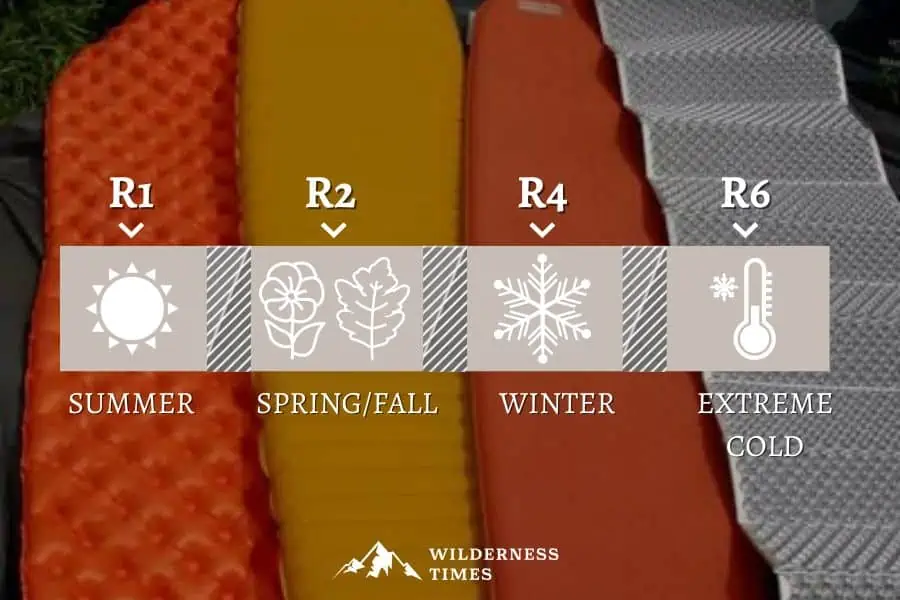
- Summer: 1 to 3
- Spring and Fall: 3 to 5
- Winter: 5 to 6
- Extreme Cold: 6+
If you’re only camping in the summer, then you can easily get by with using a sleeping pad with an R-value between 1 and 3.
Pads in this category have very basic insulation properties, so they’re not suitable for colder nights.
For 3-season camping, you can get by with R-values ranging between 3 and 5.
They’re good enough to keep you warm while temperatures are above freezing.
Sleeping pads with R-values over 5 are designated for winter camping.
Finally, anything in the R-value range of 8 is built for extreme cold.
How is R-Value Measured and Tested?
So how are these R-value numbers allocated?
Well, after the new ASTM standard, every single sleeping pad goes through the same testing.
Basically, the sleeping pad is placed between two plates, one of each side.
One is hot (about 95 degrees) and is supposed to mimic the heat of the body. The other is cold (about 41 degrees) and is mimicking the ground.
Then, the whole thing is attached to electric sensors that measure how much energy the top plate uses to remain at the same temperature.
The less energy used, the more insulating a sleeping pad is.
Are R-Values Standardized?
If you asked this question a few years ago, you wouldn’t be happy with the answer.
Back then, there was no standardization for measuring the insulating abilities of sleeping pads.
So the manufacturers would use their own ratings for their products, making comparing practically impossible.
Many brands had their own testing facilities. Without standardization, the criteria for testing were probably different between these brands.
In 2020, the American Society for Testing and Materials (ASTM), together with leading outdoor brands, created a working group for testing camping gear.
They agreed on making R-value the only way to measure the insulation of sleeping pads.
So today, you can pick any two sleeping pads and compare their stats easily.
How do Sleeping Bag Temperature Ratings Relate to R-Values?
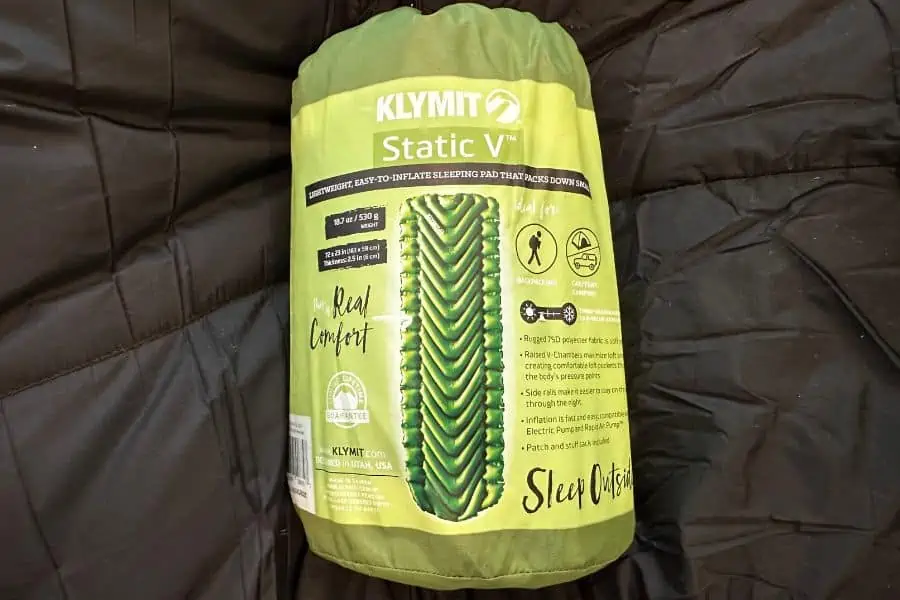
Now, just because sleeping pads are easier to compare after standardization, that doesn’t mean that buying the right gear became too straightforward.
You see, you still have to pair it with a proper sleeping bag, right?
And as you probably know, sleeping bags have a different type of rating compared to pads.
But, you’ll be glad to know that there is some kind of relationship between the two.
Sleeping bags have two ratings: comfort and lower limit. While the former indicates the temperature a cold sleeper will be comfortable in, the latter shows the comfortable temperature for a warm sleeper.
You choose between the two depending on what type of sleeper you are.
Now, this temperature rating assumes that you’re using a sleeping pad with an R-value of 5.38 or more.
At the same time, you’re expected to wear long underwear and a hat.
If your sleeping pad has a lower rating than 5.38, then expect to feel much colder at temperatures around your sleeping bag’s rating.
I know, the rating isn’t perfect, as there’s still a bit of math and guesswork involved.
But given that everyone’s sleeping preferences are different, it’s practically impossible for brands to calculate the perfect combo for every single camper.
Which R-Value is Right For Me?
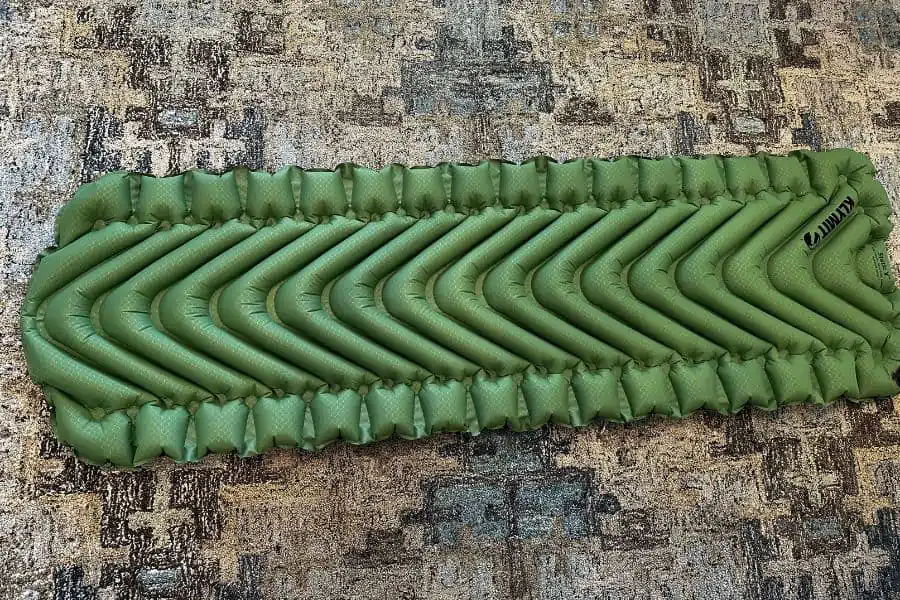
First, answer a few questions:
- What kind of sleeper are you?
- What’s your preferred sleeping position?
- How much do you weigh?
The first question is pretty straightforward. If you like being hot when sleeping, you should also consider getting a sleeping pad with a higher R-value.
As for the second, you should take into consideration that side sleepers need a higher R-value.
You see, when you’re sleeping on your side, there’s less body in contact with the sleeping pad underneath than when you’re sleeping on your back.
And the part of the sleeping pad that’s not touching you will remain cold, thus spreading low temperature across its surface.
Of course, your body weight and size also matter for the same reason. That’s why nowadays you can find kid-sized camping products.
With a sleeping pad designated for adults, your little ones would be cold at night.
You should also know that women usually need a higher R-value compared to men.
That’s because women in general have lower body mass compared to men. And the lower the mass, the less heat their bodies can retain.
With that being said, there are other things to take into consideration..
Seasons that You Camp In
Still a bit confused? Don’t worry. It took me a good while to figure out what sleeping pad is the best for my needs.
That’s why I’ll share with you a little table I made to make it easier for me to calculate the perfect rating.
SEASON | WARM SLEEPERS | COLD SLEEPERS |
1 SEASON | 0 - 1 | 0 - 1.5 |
2-3 SEASONS | 1 - 3 | 1.5 - 3.5 |
3 SEASONS (COLD, FROSTY NIGHTS) | 3 - 4.5 | 3.5 - 5 |
4 SEASONS (SUB ZERO TEMPS) | 4.5+ | 5+ |
And don’t worry. A high R-value won’t be an issue in the summer. It’s not like it has a special way of heating up.
It simply prevents the ground from affecting your body temperature.
Therefore, a sleeping pad with an R-value of 10, for instance, will be comfortable in the summer as well.
Backpacking Weight Considerations
What if you’re backpacking? Naturally, you want to go as low on weight and bulk as possible. But does that mean sacrificing warmth and comfort?
Well, generally, the lighter the pad, the lower the R-value since it is made of less material.
Of course, by paying a bit more, you can always find a product that hits the perfect balance between weight and warmth. But for extra comfort, you have to be ready to carry more.
If you’re set on going light, then you should consider the choice of the material.
How is Your Sleeping Bag Rated?
As we already covered, sleeping bag ratings are based on the use of a sleeping pad that has an R-value of 5.38.
So, if you own a sleeping bag with a temperature rating of 30, that means a sleeping pad of 5.38 or above is great for most part of the year.
As long as the temperatures are above the freezing point, you should be warm.
If you have a very thick sleeping bag with a temperature rating of 15, then you can easily use a sleeping pad designated for 1 to 2 seasons without getting cold from spring to fall.
R-Values of Popular Sleeping Pads

Now that sleeping pads are standardized, they’re easy to compare.
And given that R-value is your main criterion when choosing a model, I thought it would be useful to create a list of the most popular models on the market with their respective R-value pads.
Which sleeping pad has the highest R-value?
This was the first question that pop into my mind, and you might be wondering the same.
The higher the R-value, the better insulation a sleeping pad has. So which one has the best insulation out there?
At this moment, HEST Sleep System is currently the best insulating sleeping pad on the market. With an R-value of 11.8, very few models even come close.
It achieves this with two layers of polyfoams that are 7 inches thick.
Of course, it’s clear that you have to sacrifice a bit of weight and storage space for warmth. But in freezing cold temperatures, that’s well worth it.
List of R-Values for Popular Pads
Here’s a list of the most popular sleeping pads you can find currently on the market.
BRAND | R-VALUE |
ALPS Mountaineering Nimble Double | 3.9 |
ALPS Mountaineering Outback | 8.5 |
ALPS Mountaineering Swift | 2 |
Big Agnes Hinman | 5 |
Big Agnes Insulated Air Core Ultra | 1.4 |
Big Agnes Insulated AXL | 3 |
Big Agnes Rapide SL | 4.2 |
Big Agnes Twistercane BioFoam | 1.7 |
Cedar Ridge Odyssey | 2.5 |
Exped Deepsleep Mat | 8.5 |
Exped FlexMat | 1.5 |
Exped Megamat Duo 10 | 8.1 |
Exped MegaMat Max 15 | 10.6 |
Exped Ultra 3R | 2.9 |
Exped Versa 2R | 2.4 |
HEST Sleep System | 11.8 |
Kelty Galactic Air | 2.6 |
Kelty Mistral Si | 4.7 |
Klymit Klymaloft | 2.3 |
Klymit Static V2 | 1.3 |
Mountain Equipment Helium 3.8 Warm Zone Sleeping Pad | 3.6 |
Mountain Summit Gear Camp Pad | 5.7 |
NEMO Astro Insulated | 2.6 |
NEMO Flyer | 3.3 |
NEMO Quasar | 3.3 |
NEMO Roamer | 6 |
NEMO Roamer SI | 6 |
NEMO Switchback | 2 |
NEMO Tensor Ultralight Insulated | 4.2 |
Rei Co-op Air Rail Plus | 3.3 |
Rei Co-op Camp Bed | 7.6 |
REI Co-op Helix | 4.9 |
Rei Co-op Kindercamp | 4.5 |
Rei Co-op Trailbreak | 5.1 |
Sea to Summit Ether Light XT Air | 1.2 |
Sea to Summit Ether Light XT Extreme Insulated Air | 6.2 |
Sea-to-Summit Camp SI | 4.2 |
Sea-to-Summit Ultralight Air | 1.1 |
Term-a-rest Trail Scout | 3.1 |
Therm-a-rest BaseCamp | 6 |
Therm-a-rest MondoKing 3D | 7 |
Therm-a-Rest NeoAir Topo | 2.3 |
Therm-a-rest NeoAir Xlite | 4.2 |
Therm-a-rest NeoAir Xtherm | 6.9 |
Trekmates Air Lite | 2.2 |
Trekmates Bomberlite | 4 |
Zempire Monstamat Twin | 10.5 |
Faqs
Does Sleeping Pad R-value matter?
The R-value is a standardized measurement of how insulating a sleeping pad is.
That means it shows you the ability of your sleeping pad to keep your body warm while sleeping.
The higher the number, the better the pad it is at doing that.
Of course, you’ll also need to use an adequate sleeping bag with it to make the best use of its insulating ability.
What if my Sleeping Pad R- Values are not shown?
If your sleeping pad doesn’t have an R-value shown, that means you’re using an older models.
Up until 2020, there was no standardized rating and testing of sleeping pads, and some brands avoided doing that altogether.
If the brand still sells your model, check the newer products for the rating.
What makes a sleeping pad insulated?
A sleeping pad without insulation doesn’t have any type of filling inside, except for air.
This makes them easy to pack down and lightweight, but that also means you’ll lose body heat through the ground at night.
Insulated sleeping pads will have some sort of filling that prevents or lowers the transfer of heat between two sides of the pad.
This can be foam, closed-cell or even a heat-reflective material.
Does a higher R-Value cost more?
It can, but not necessarily. In the majority of cases, the brands use more material to create a better layer of insulation.
But that also depends on the material used. For instance, foam can be thin and still retain heat really well.
What is a good R-value for a sleeping pad?
A good R-value for a sleeping pad will depend on the seasons that you are camping in, the expected temperatures you’ll encounter, and the warmth of your sleeping bag.
But generally speaking, during the summer an R-value of 1 to 3 will be good. For fall and spring you’ll want a sleeping pad with an R-value between 3 to 5. And lastly, for winter and extreme cold situations you’ll want to look at sleeping pads with R-values of 5 to 10.
How do I increase the R-value on my sleeping pad?
You can’t increase the r-value of your sleeping pad, but you can increase your warmth by adding additional insulation layers.
The additional insulation layers could be a mylar/emergency blanket, a camping rug, a closed-cell foam mat, or a thick blanket.
The more layers you have between the cold ground and your body, the warmer you will be.
To Sum Things Up
As you can see, deciphering the R-value of a sleeping pad isn’t exactly rocket science.
It allows you to compare different models and pick the one most suitable for you.
However, you still need to take other factors into consideration when choosing the best model.
These include the preferred sleeping position, the type of sleeper you are and the weather you usually camp in.


